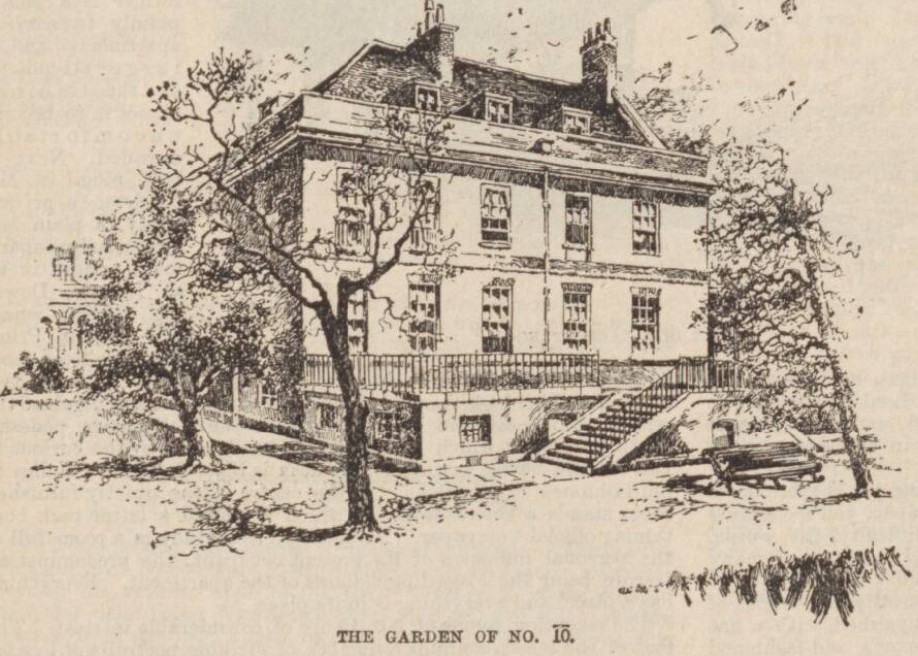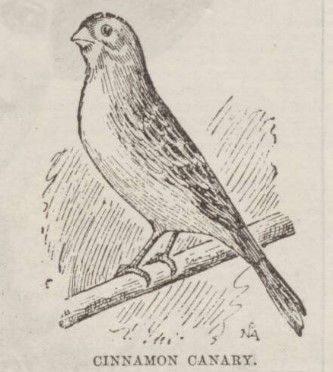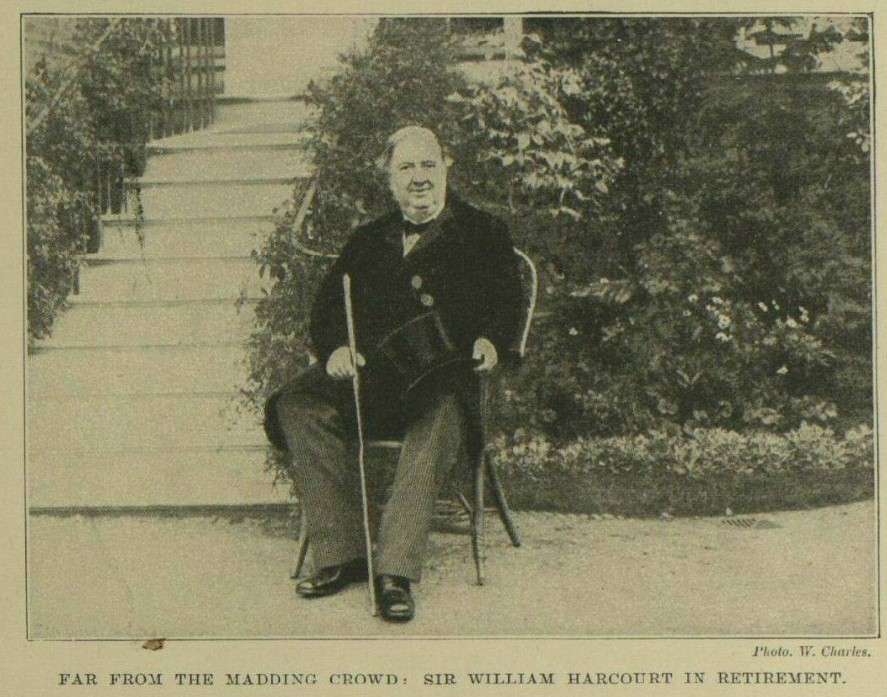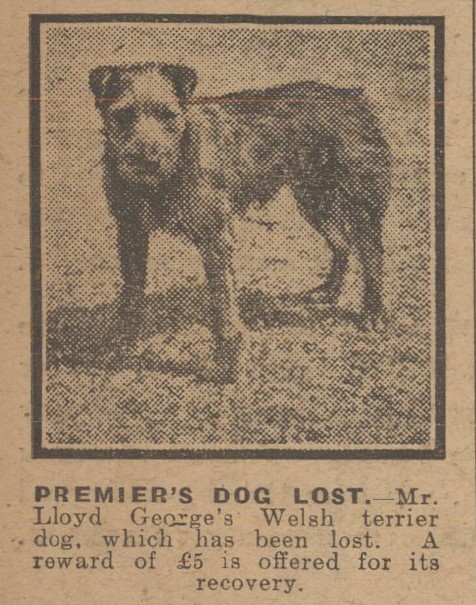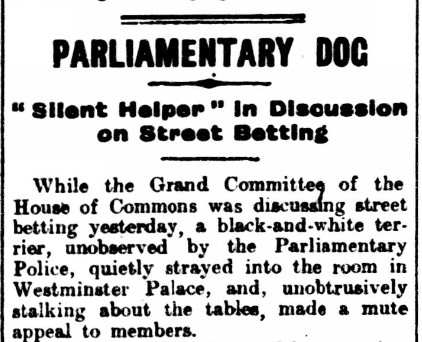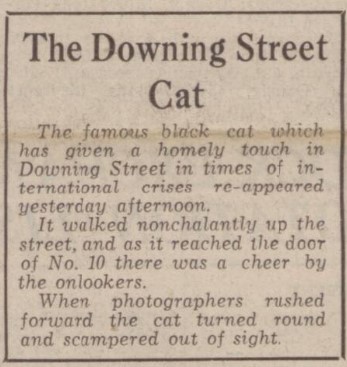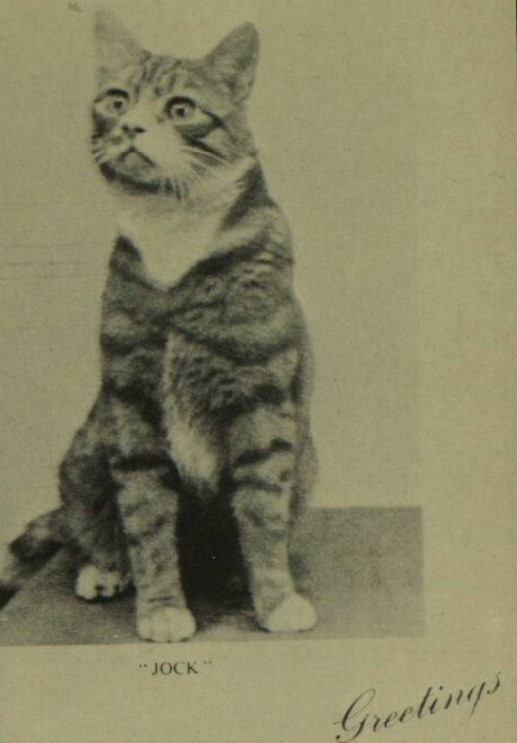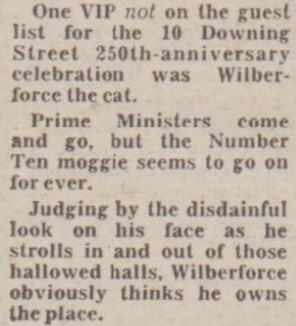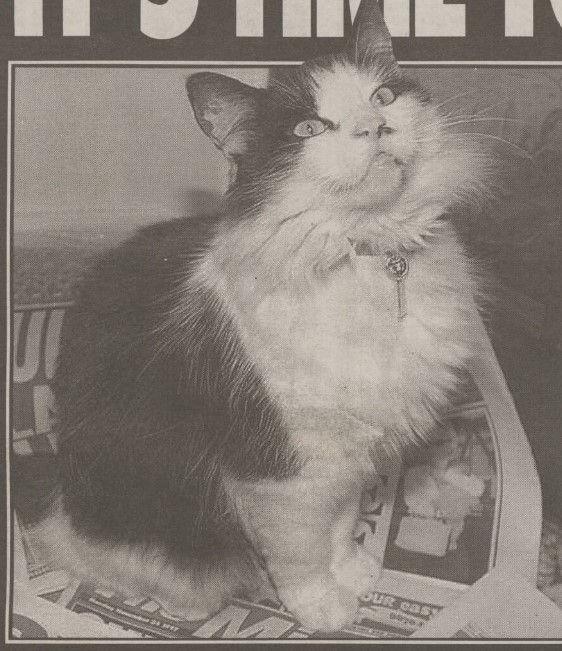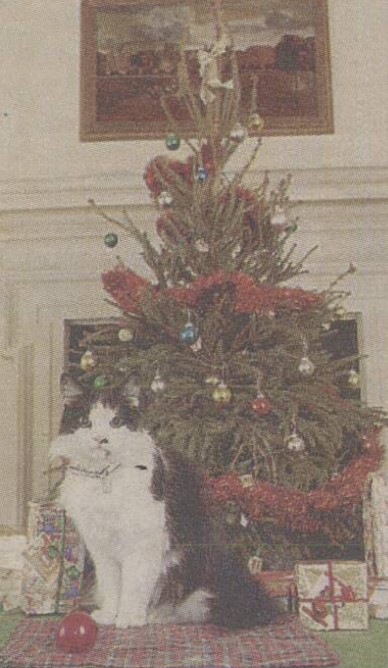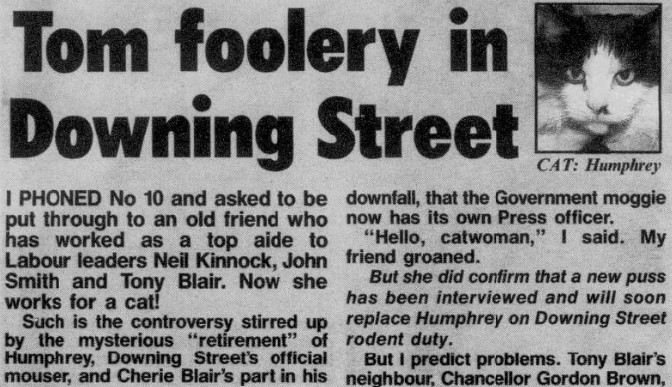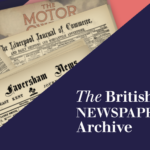From David Lloyd George’s Welsh terrier to John Major’s sunburnt goldfish, British politics has a rich history of parliamentary pets. These pets in office often stole the limelight from their human colleagues, and were sometimes even officially employed in their roles.
In this special blog, we detail twelve parliamentary pets, from canaries to cats. We look at how some animals became symbols of good luck, and how others contributed to political storms. We tell their stories using pages from our newspapers, as we cover over one hundred years of political pet history.
Register now and explore the Archive
1. Tom the Cat
It’s in 1892 that we begin, with some sad news that was reported by the Manchester Evening News on 22 January 1892. These tragic tidings pertained to Tom, a cat who for fourteen years previously, ‘had taken up its abode in the sentry-box opposite the Premier’s official residence in Downing-street.’
The Manchester Evening News describes Tom as both ‘a Downing Street pet’ and ‘a general favourite,’ the feline having been ‘frequently noticed and petted by the late Lord Beaconsfield, Mr. Gladstone, Mr. W.H. Smith, Lord Salisbury, and the late Earl of Iddesleigh.’
However, ‘to the general grief of the inhabitants in the vicinity,’ this parliamentary pet ‘was set upon by two bull terriers, and after a brave fight, was killed.’
2. The Chancellor’s Canary
Downing Street may have been described as a veritable menagerie in the 1890s, as one book, published in 1923, recalled ‘Some Bygone Figures in Whitehall.’
The Oxford Chronicle and Reading Gazette explained how one of these bygone figures was a pet canary, which belonged to the then Chancellor of the Exchequer, Sir William Harcourt (1827-1904). This canary lived at Harcourt’s ‘residence in Downing Street,’ but it seems it was not quite happy with its lodgings.
For, as the Oxford Chronicle and Reading Gazette relates, it ‘escaped a few years before the General Election in 1895.’ It might have sensed trouble was in the air for its owner, for the Liberal party lost power, and Sir William Harcourt was out of office, then becoming the Leader of the Opposition.
However, happily for Harcourt and his household, the canary ‘was recaptured soon after’ its bid for freedom.
3. Topsy and Tom
In January 1903 another parliamentary pet went missing, with its absence being reported in the Dundee Evening Telegraph on 7 January 1903. With the headline ‘Lost! The Downing Street Cat,’ the article inquired if ‘anyone [had] seen Mr. Balfour’s cat?’
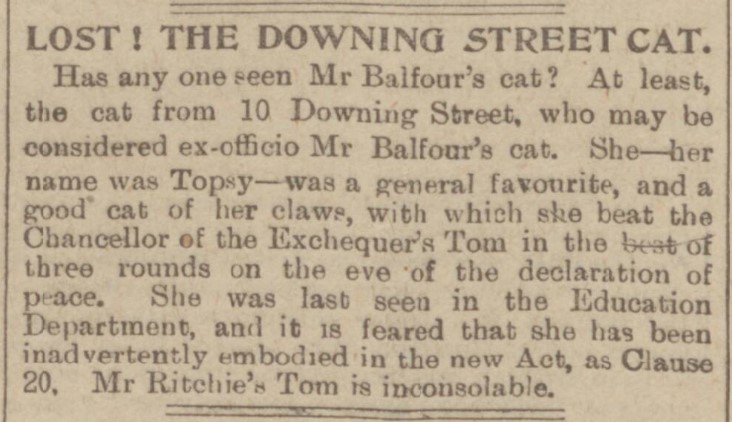
Dundee Evening Telegraph | 7 January 1903
Topsy was a female cat, who, like her predecessor Tom, ‘was a general favourite.’ Indeed, she was ‘considered ex-officio Mr. Balfour’s cat,’ and was labelled by the newspaper as a ‘good cat of her claws.’ Topsy was a fighter, as she had beaten ‘the Chancellor of the Exchequer’s Tom in the best of three rounds on the eve of the declaration of the peace.’
But now Topsy was nowhere to be seen, having last been sighted at the Education Department. Not only did her absence leave the Prime Minister Arthur Balfour (1848-1930) bereft, but the Chancellor of the Exchequer’s cat, Tom, was ‘inconsolable.’
4. Cats in Office
So popular were parliamentary pets becoming that in 1907 society magazine The Tatler featured a spread of ‘Cats in Office,’ with the subheading ‘Mieous from Whitehall.’
The article differentiated between the office cat and the official cat. The office cat, so says The Tatler, ‘seldom has any locus standi and lives on charity all year round.’ The official cat, however, ‘is a recognised member of the community and has a fixed allowance for food and other necessities.’
In 1907 there were quite a few of these official cats gracing government buildings, and The Tatler photographed seven of them.
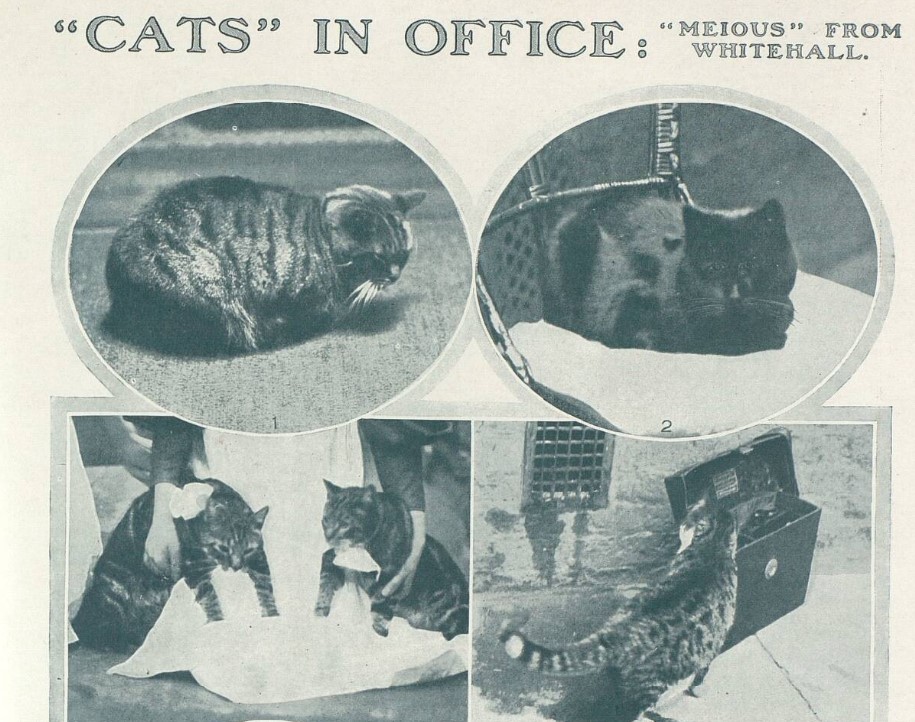
First up was Tommy Liza, the Privy Council Cat, who was ‘always in disgrace in spite of his sixteen years.’ His ‘favourite resting place’ was Lord President of the Council Lord Crewe’s chair. Next to be featured was Toby, ‘the Home Office cat, eleven years old and a sufferer from chronic asthma.’
Then there was the duo of Tits and Tats, who lived at the Mansion House. Tits and Tats were ‘lively youngsters,’ who ‘evinced a great dread of the camera, and like the small infant [had] to be held in position to have their photograph taken. Meanwhile their counterpart at the Board of Education, Joe, was described as a ‘terror to the pigeons living near by.’ Joe, it seems, would not pose for the camera either, his ‘bump of curiosity’ leading him to investigate the photographer’s equipment instead.
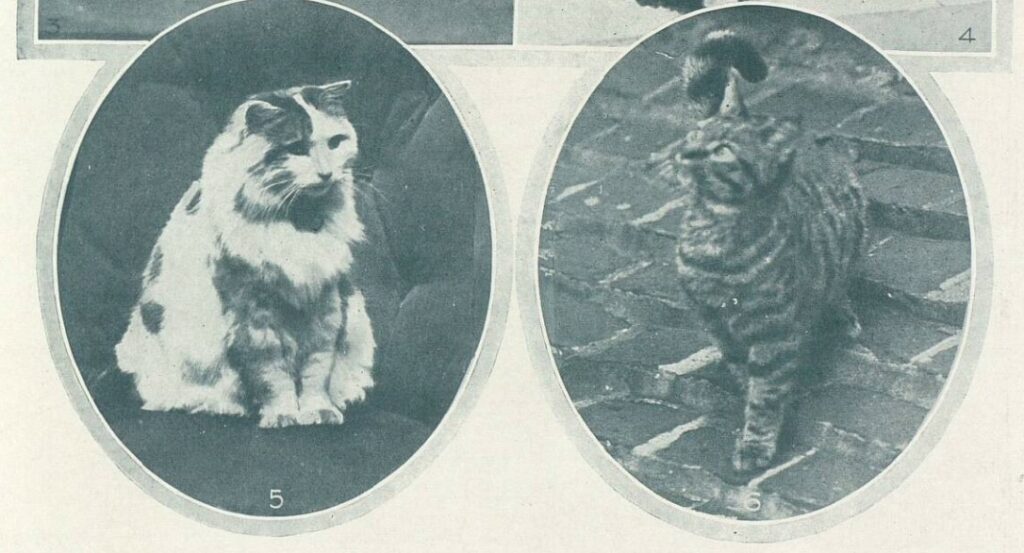
The penultimate parliamentary pet to be featured by The Tatler was the wonderfully named Trillie Williams, the War Office cat. Trillie Williams was nine-years-old, and was continually sleepy, having a ‘preference for the cook’s bed.’ Finally there was Duke, the Paymaster General’s cat, so named because he was ‘an importation from the Duke of Wellington’s house at Strathfieldsaye.’ Duke was just five-months-old, and believed ‘in plenty of exercise.’
5. Cymro the Dog
The parliamentary pets that we have featured so far have favoured felines, but Prime Minister David Lloyd George’s dog hit the headlines in August 1918. On 3 August 1918 the Croydon Times reported how the Prime Minister’s ‘pet Welsh terrier’ had been ‘lost at Sutton on July 19th whilst Mr. Lloyd George was addressing a War Weapons Campaign meeting.’
A reward of £5 was subsequently offered for the return of the missing hound, which was claimed by a ‘resident of Redhill.’ The good Samaritan had come across Cymro ‘wandering about,’ and had given ‘him a temporary home.’
6. A Terrier in the House of Commons
Whilst Cymro had escaped from his owner, one dog in June 1923 found its way into the Palace of Westminster, into a room where the Grand Committee of the House of Commons was discussing street betting. The Daily Herald on 8 June 1923 described how a black and white terrier ‘quietly strayed into the room in Westminster Palace, and, unobtrusively stalking about the tables, made a mute appeal to members.’
The terrier’s appearance seemed like a welcome distraction for the committee. The newspaper reported how ‘he was stroked and petted by a number of the M.P.s.’ Indeed, the Daily Herald commented how the terrier was far from being ‘a Derby dog, the historic outlaw of the classic course, that usually becomes a target for all kinds of cannonading and curses.’
Indeed, the Derby dog was a creature of legend, a masterless animal who was sure to appear as soon as the Epsom course was cleared for the great race of the season. Now this terrier might have been masterless, but he caught the Speaker’s eye, as well as that of Mr. H.S. Cautley K.C., the M.P. who was the chairman of the committee. Indeed, Cautley ‘had no occasion to call him to order’ and ‘he only whispered something in the dog’s ear.’
After walking around the room for some time, ‘the animal thereupon lay down beside the chair and was not heard in the discussion.’ But who did this mysterious dog belong to? The Daily Herald revealed that the terrier was wearing a collar, which read ‘Gurney, 83, Vauxhall Bridge-road, S.W.’
7. Bob – ‘An Omen of Good Luck’
As the war clouds gathered once more over Europe, one parliamentary pet was on hand to offer succour, Bob, the Downing Street cat. Bob had been sighted during the Munich Agreement, and was once more spotted on 28 August 1939, just days before the Second World War broke out.
Indeed, his appearance made the pages of the Dundee Courier, which reported how:
The famous black cat which has given a homely touch in Downing Street in times of international crisis reappeared yesterday afternoon. It walked nonchalantly up the street, and as it reached the door of No. 10 there was a cheer by the onlookers. When photographers rushed forward the cat turned round and scampered out of sight.
The passing of Bob the cat also hit the headlines, the Aberdeen Press and Journal relating on 5 August 1943 the news of his sad demise:
‘Bob,’ the Downing Street black cat, is dead. One of the most photographed cats in the world, it sat on the steps of No. 10 at all important occasions during the Munich crisis. It was regarded as an omen of good luck.
8. Churchill’s Cat
Wartime Prime Minister Sir Winston Churchill was a great cat lover, and his cat Jock is one of the most famous parliamentary pets in history. Jock was given to Churchill on his 88th birthday by the statesman’s private secretary Sir John ‘Jock’ Colville.
On 7 September 1968 the Illustrated London News profiled the famous feline, detailing how ‘Jock was Sir Winston Churchill’s cat, a fact for which the Royal Society for the Prevention of Cruelty to Animals, not to mention Sir Winston and Jock, have considerable cause to be grateful.’
For Jock, as the article relates, was something of a ‘money spinner’ for the RSPCA. He fronted the charity’s greeting cards, and also appeared on a charity calendar. But Jock was only giving back, as the Illustrated London News detailed, for the marmalade cat himself had been adopted from an RSPCA clinic.
And whilst Churchill was fond of Jock, Jock was fond of Churchill. It is said that the cat sat on his bed as the former Prime Minister passed away. The legacy of Jock lives on to this day: the Jocks of Chartwell, Churchill’s home which was bequeathed to the nation, are currently on their sixth incarnation, Jock VI.
9. The Best Mouser in Britain
Following in the footsteps of his illustrious parliamentary predecessors was Wilberforce the cat, who was adopted from the RSPCA in 1973, when Edward Heath was Prime Minister. Dubbed ‘the best mouser in Britain,’ Wilberforce would go on to serve four Prime Ministers.
News of Wilberforce’s passing at the age of fourteen hit the pages of our newspapers, the Aberdeen Evening Express reporting on 19 May 1988:
The 10 Downing Street cat Wilberforce, which ‘served’ four Prime Ministers over 14 years by solving its mouse problem, died today.
10. The Sunburnt Fish
A parliamentary pet of a different nature hit the headlines in 1995, with the Aberdeen Press and Journal on 14 September 1995 captioning the story ‘Mr Major’s Fishy Joke.’ The article began:
Heard the one about three party leaders who were seen on TV sharing a joke during a break in VJ Day proceedings at Horseguards Parade, London, last month? There was much speculation as to what prompted the outbreak of humour between John Major, Tony Blair and Paddy Ashdown. And the answer was revealed yesterday – the Prime Minister’s pet goldfish.
Indeed, the Aberdeen Press and Journal revealed how ‘expert medical attention was needed when the fish, from a pond in the garden of Mr Major’s Huntingdon home, was diagnosed as having sun stroke.’ The sun-stricken fish ‘was taken from its watery living quarters and an attempt was made to revive it – using sun cream.’
It was Liberal Democrat leader Paddy Ashdown who revealed this piece of information, the politician stating that he hoped he was ‘not breaching Cabinet confidentiality’ in discussing the poorly fish. He did not know, however, whether or not the fish survived, and the Aberdeen Press and Journal reported how ‘Downing Street declined to enlarge,’ going on to quip ‘being a goldish, perhaps the Treasury knows!’
11. Humphrey the Celebrity Cat
Whilst such fishy jokes were being made, parliamentary pet Humphrey was employed as ‘chief mouser’ at Downing Street, following in the footsteps of his predecessor, Wilberforce. Humphrey had arrived at Downing Street in 1989 as a stray, like Bob the ‘omen of good luck’ some fifty years before him.
However, in 1995, Humphrey went missing. But on 27 September 1995 national newspaper the Daily Mirror reported on his safe return, detailing how ‘Humphrey the Downing Street cat has been found safe three months after disappearing.’ The famously Labour supporting newspaper then quipped ‘if his master went missing, no one would notice.’
Humphrey’s disappearance caused something of a stir, elevating the feline’s public profile. On 29 September 1995, a few days after his return, it was reported by the Daily Record how ‘cat food bosses hoping to make Downing Street pet Humphrey a TV ad star were yesterday warned: ‘Paws Off.” Humphrey, ‘a star of the media since returning to Number 10,’ was employed as Downing Street’s official mouser. And so, ‘as a civil servant, it would be against his contract to take advertising work.’
In November 1996 Gregory Holyoake, writing for the Illustrated London News, provided a little more background on the Downing Street Cat:
Humphrey, the Downing Street cat, is named after Sir Humphrey Appleby, the fictional Permanent Secretary of the popular BBC TV series, Yes, Minister. He is approximately seven years old and arrived as a stray in 1989, when he was immediately adopted as official mouser. He is a fluffy black and white cat with a gentle nature and is looked after by clerical staff.
Indeed, Holyoake outlined how ‘there has been a history of Cabinet Office and Treasury cats since the reign of King Henry VIII,’ with Humphrey following in this rich tradition. But perhaps Humphrey had gained the greater fame; when he went missing, he was presumed dead, ‘and his obituary was printed in The Times.’ Thankfully, as Holyoake describes, his photograph was recognised by a policeman at the Royal Army Medical College at Millbank, who had taken him in, and he was soon reunited with ‘his friends at the Cabinet Office.’
And whilst Humphrey was not made the face of any cat food brand, he was able to ‘rub shoulders with Prime Ministers, heads of state, and royalty.’ In 1995 he had ‘his portrait painted by an artist admirer,’ and an autobiography was written for him, which became a Christmas bestseller.
12. Caterwauling and Cat Fights at Number 10
Superstar Humphrey’s tenure at Downing Street was not to last, despite Gregory Holyoake’s assertion that ‘if there is a change of government he will remain at No 10.’
In November 1997 Lucy Laing for the Liverpool Echo reported on Alfie the Town Hall cat, who had recently been adopted by Liverpool’s Lord Mayor Margaret Clarke. The black and white cat, however, could not stay at the Town Hall, because of the ‘sensitivity’ of the 17th century building’s alarms. Alfie needed a new home, therefore, with Cats Protection League fundraiser Jean Ellis stating:
‘It’s the opposite of the situation facing Humphrey the Downing Street cat who has been retired – Alfie is just starting on a new career.‘
You read that right, the country’s chief mouser Humphrey had controversially been retired. On 30 November 1997, Nigel Nelson for The People reported on ‘Tom foolery in Downing Street.’ Nelson penned:
Such is the controversy stirred up by the mysterious ‘retirement’ of Humphrey, Downing Street’s official mouser, and Cherie Blair’s part in his downfall, that the Government moggie now has its own Press officer.
Despite rumours of the Prime Minister’s wife’s allergy to cats, the Downing Street spokesperson confirmed ‘that a new puss has been interviewed and will soon replace Humphrey on Downing Street rodent duty.’ Nelson, however, saw trouble ahead:
But I predict problems. Tony Blair’s neighbour, Chancellor Gordon Brown, is expected to marry girlfriend Sarah Macaulay soon. Sarah has a tom called Felix who will move to No 11. ‘Felix is ferocious,’ a chum of the Chancellor tells me.
He continued:
So will caterwauling and cat fights now disturb Tony and Cherie’s beauty sleep? ‘There’ll be two cats in Downing Street!’ said my No 10 friend, a touch desperately. ‘The place will be alive with cats!’
Meanwhile, Leatherhead Advertiser reporter Louise Halfpenny decided to hit the streets on 4 December 1997 to find out who the public wanted to replace the legendary Humphrey. Suggestions were for a corgi, as a small dog would suit the limited space of Number 10, or, following in the footsteps of John Major, for a goldfish, as ‘they are no trouble to look after.’
The final suggestion was from Janet Palfreeman, from Wallington, who commented how ‘A Rottweiler would suit them.’
Indeed, Humphrey would not be replaced until the Blair administration came to an end. He was succeeded by a short while by Sybil, the cat of Chancellor of the Exchequer Alastair Darling, who was in turned succeeded in 2011 by the present mouser, Larry. Larry has, up until this point, served five different prime ministers.
Discover more about parliamentary pets, political happenings, and much more besides by browsing the pages of our Archive today.


